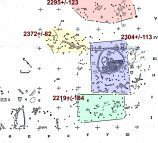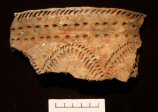
Figure 13: Serteya 2. Pile structures
Two distinct cultures belong to this unit, both featuring the continued use of pile dwellings. The pottery of the earlier, Zhizhitsian, is basically similar to that of the Usvyatian with the addition of several novel ornamental patterns. Considerable changes are noted in the composition of the stone inventory. A total disappearance of the bone and antler industry is remarkable.
Zhizhitsian levels have been identified at several sites in the Serteya valley. Excavations in the drainage canal at Serteya 2 with the use of underwater techniques have revealed six dwelling structures, consisting of platforms resting on piles (Fig. 13). Wooden structures were made of Picea, Pinus, Fraxinus, Acer and, rarely, Quercus. The overall area of pile dwellings at this site is estimated as c. 600 sq.m.

Figure 13: Serteya 2. Pile structures
In total, 35 radiocarbon dates were obtained for wooden structures belonging to the houses, each of which had apparently been constructed during a single season. Hence, the dates from each structure characterise a momentary event in the sense of radiocarbon dating. Several samples were taken from different sets of year-rings of a single pile. The empirical error has been calculated for four sets from Structures 1, 2, 3 and 6. In the case of Structure 1, all dates form a Gaussian-like distribution with one date obviously falling out. The mean age of the remaining dates is 2304 BC with a standard deviation of 113 years. The corresponding values for the other structures are: 2372±83 BC for Structure 2; 2295±129 BC for Structure 3 (with one outlier), and 2219±184 for Structure 6 (with one outlier). The average age of all four structures is 2298±127 BC. The standard deviation of 127 years is considered as a conservative estimate for the duration of a single pile dwelling.
The most spectacular changes are discernible in the layers attributed to the North-Byelorussian culture. The shape and ornament of the pottery vessels in some cases show similarities with the European 'Corded Ware' cultural horizon (Fig. 14). Animal remains at North-Byelorussian sites include a limited number of domesticates: cattle, sheep/goat and pig.

Figure 14: Zhizhitsian pottery (Serteya 2 site)
© Internet Archaeology/Author(s)
University of York legal statements | Terms and Conditions
| File last updated: Wed Dec 15 2004